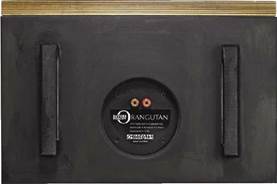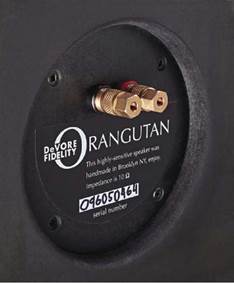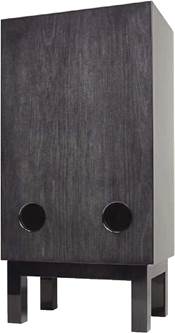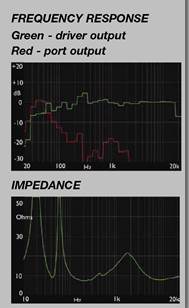Devore’s Orangutan 96 loudspeaker delivers big sound from little power. Noel Keywood finds less is more. DEVORE FIDELITY ORANGUTAN 0/96 Review
Here’s a high-end loudspeaker, that exploits old values: large cabinet, high sensitivity and a relaxingly large sound, achieved through modern technologies. Designed with low power valve amplifiers in mind, DeVore’s Orangutan 96 is an unusual design with an unusual name.

OK, I was baffled by the name: ‘Orangutan’ made little connection with this loudspeaker as far as I could see – unless squat shape and equatorial veneer are the link I missed. Steering away from monkey talk though, the 96 suffix doesn’t imply lots of them so much as very high 96dB claimed sensitivity. The suggestion is Orangutans can blow your head off from just one Watt of amplifier power, making specialised 9 Watt singleended designs suitable. Transistor amplifiers suit but high power will go unused.
Can you see the picture that is building? We are looking at an esoteric branch of high fidelity here, one that appeals to me: high sensitivity loudspeakers – think Tannoy – coupled with low power amplifiers (Leak?) offer a sound like no other, one that millions around the world know and love.
In the UK think Tannoy (now gone it seems), Leak, Audionote. DeVore Fidelity are based in New York so join McIntosh and New Sensor in their connection with valves (tubes) in that big city.
Wish there were some companies like that in London, where I sit! Geography apart though, the picture remains the same: highly sensitive loudspeakers have a reputation for lifelike dynamics that engage.
And that’s what I found with the Orangutan 96, fed just a few Watts from our Icon Audio Stereo30 SE single-ended valve amplifier. The Icon delivers 30 Watts from modern KT150s I’ll quickly note; a single-ended using the famed but old 300B manages just 9 Watts. So that’s the power range we’re looking at here – but it’s more then enough to shake a room with the Orangutans.
To do this a loudspeaker must have a large volume cabinet, allied to an efficient drive unit, meaning one with a powerful magnet and a motor with small clearances. In the Orangutan 96 DeVore Fidelity use their own spec. bass/mid driver with a 25cm (10in) wood fibre cone, they say. The motor is from SEAS and the cone from “another European supplier’, likely Kurtmueller. Measurement showed it works up to 2kHz before cutting off sharply to a 25mm (1in) silk dome tweeter that sits inside a shallow horn.
The two custom drivers sit in a large cabinet measuring 46cm (18in) wide, 72cm (28.4in) high and 30cm (12in) deep. A pair of matching wooden stands are supplied, raising the speakers to 90cm (36in) height. Because

connection is from below, via two copper Cardas loudspeaker terminals (no bi-wiring then) the cabinets must sit on their open open stands. I found myself lying on the floor with a torch to make certain connection was perfectly made, so not the most practical connection method, but then loudspeakers under review are heavily manipulated during measurement, running-in and auditioning. Owners would likely connect once and forget. This leaves the rear panel free for two ports that load a single chamber behind the 10in bass unit.
The ‘speakers come with a plywood front panel and MDF cabinets, veneered with Ebony in our case but the ‘speakers are built to order and other veneers are available. A clear lacquer is used to provide a hard wearing, high gloss finish and ours had their own visual charm, especially with the grilles on. I was happy enough with the wide front baffle but the drive units have no trims to cover fixing

screws, a lack detail finish the black grilles covered up. They attach by magnets and measurement showed the open weave cloth is acoustically transparent.
SOUND QUALITY
Connection to our Icon Audio Stereo30 SE single-ended valve amplifier (30W) was via Chord Company Signature Reference screened cables. Sources were an Oppo UDP-205D CD player with its ESS ES9038Pro DAC, plus a MacBook Pro running from battery for isolation, feeding hires and DSD to the Oppo via an Audirvana+ software player, over USB.
I had to run LP of course, from our Timestep Evo modified Technics SL-1210 Direct Drive turntable fitted with SME309 arm and Audio Technica OC9X SH (Shibata) moving coil cartridge, connected balanced into a ProJect RS2 balanced phono stage, its unbalanced output feeding our Stereo30 SE.
As you might expect, the Orangutan 96s have large-speaker presence, just like the big boxes of yore, if with a greater sense of control and precision. The bass line behind Josefine Cronholm’s Gates of Istanbul was fluid and strong, with the dynamic liveliness that I had hoped to hear. It was confidently relaxed in its power, yet smoother in note amplitude than most, especially boxes from the past.
As the tracks flowed by I was never worried about these speakers ability to handle what was on offer in the low registers. With just a few Watts producing room-moving bass the power meter of our Icon Audio Stereo30 SE amplifier was flickering against its end stop, so little power was being used. We’re talking milliwatts here.
Measurement revealed a rear cabinet wall reflection and there was classic big-box sound as a result. Having graduated from this to open panel electrostatics long ago it was plainly obvious to me: the Orangutans were
a tad chesty with deep male vocals like Eric Bibb singing Going Home (DSD128). However, for the most part I was serenaded by their smoothness and gentle insight. I was even lulled by it. Where loudspeakers are nowadays expected to impose themselves on the music to throw it at you, usually with sharp treble, these ‘speakers just got it right. Awkward tracks that I use for review were easy to enjoy: no edge-of-seat listening to Willy DeVille (CD) singing Spanish Harlem. The sibilant spitch of his vocals into the microphone was there but not life threatening.
I enjoyed the creamy smooth sound of the tweeter, its lack of hardness or sharpness made cymbals ring convincingly in Cyndee Peters House of the Rising Sun (DSD128). There’s was plenty

of detail – naturally delivered. That’s mainly down to lack of a crossover dip between bass/mid and the treble unit, the 2-3kHz region being responsible for apparent detail in the sound. High quality DSD such as this made obvious their dynamic liveliness; lone triangle strikes rang out with a solidity that’s unusual and vocals jumped at me. The Orangutans fulfil their promise of a vivid and engaging sound.
With quality classical recordings the Orangutans sorted out the spacial positioning of orchestral sections impressively well by giving brass solid fruity rasp in Korsakov’s Dance of the Tumblers (24/96), whilst strings had their own sense of vivacity. Images were not razor sharp at

edges, but within the context of an orchestra it isn’t to be expected, instead there was a sense of easily delivered scale that I found exciting. And kettle drum strikes carried power. A tonally accurate natural balance – avoiding screech from violins for example – plus sheer dynamic scale made the Minnesota Orchestra loom large in my room.
Spinning LP brought a similar presentation; the speakers tend to dominate the sound. There was a similarly lively sound and plenty of deep bass from drums in the Syd Lawrence Orchestra’s live studio album Big Band Spectacular. The brass section had a strong rasp, if with a little muddle that likely came from the large fibre cone of the bass/mid unit. The overall impression though was one of scale and life, of a big band playing in the room. The Orangutans suited live performances like this. With classic Rock like Dire Straits Walk of Life and Your Latest Trick, from Mobile Fidelity’s re-master of Brothers In Arms (45rpm), kick drum had large presence, bringing weight to the sound, with a lively but soft quality.
CONCLUSION
The Orangutan 96 carries with it a very particular view of high fidelity. I know it well having been raised on the sound of a big, lazy loudspeaker that can shake a room with alacrity, mighty Tannoys being a prime example. But where the Yorkminsters, GRF90 and Westminsters I have reviewed in the past needed a matching mansion, the Orangutans are more considerate. You still get worked over by a Watt, but in a normal living room!
The promise of lively dynamics and a slickly fast delivery was met: few loudspeakers manage to produce so much from so little. With massive sensitivity, vivid dynamics and ever strong low bass, the Orangutan 96s were nothing short of impressive. Tailored to suit low powered valve amplifiers, they are well worth hearing.

A pair of large rear ports are tuned to 45Hz and contribute strongly to low bass.
MEASURED PERFORMANCE
With grille off our third-octave pink-noise analysis shows an almost ruler flat response from 400Hz up to 16kHz – an impressive result. The tweeter cuts in suddenly at a low 2kHz and it delivers smooth output all the way to 16kHz, suggesting treble free of sharpness or colouration. The smoothness of response is similar to that of a ribbon tweeter so this is a high quality drive unit, if not with the sound of a ribbon because it is not made from aluminium. With grille on there was slight (-1dB) loss around 8kHz, so some slight softening of bite will be audible.
Below 2kHz the single bass/midrange driver provides output down to a low 30Hz, albeit with slowly falling output below 200Hz. This will be counteracted by ‘room gain’ of a room up to 20ft long to give a net flat result, making the Orangutan potentially a well balanced and accurate loudspeaker.
The ports provide output sharply tuned to 45Hz (red trace), suggesting there will be lively resonant deep lows, giving the feeling of bounce in the bass.
Our impedance curve confirms this by the high peaks around the port’s dip, suggesting a strongly resonant system with a lot of reactive electrical/mechanical energy storage, more than most loudspeakers. The suggestion here is a less damped more lively sound than is common.
One obvious problem revealed by our response analysis is a peak at 300Hz that the red port output trace shows is a phase rotation, caused by reflection from the rear cabinet wall 28cm behind the bass unit. This is to be expected from a large bass unit in a shallow cabinet: colouration is likely.
DeVore claim massively high 96dB sensitivity, a figure no ordinary loudspeaker achieves. We measured 92dB from one nominal Watt (2.8V) of input – very high by current standards and sufficient for low power (9W) valve amplifiers. Impedance measured 12 Ohms, so less than one Watt was being consumed and a true Watt would have produced more volume, but this is academic except with valve amplifiers having a 12 Ohm output winding, which none do. The voltage sensitivity is sufficiently high to suit amplifiers of 9W or more, valve or transistor.
The Orangutan measured well all round, being accurate and very sensitive. NK

DEVORE FIDELITY ORANGUTAN 0/96
Absolute Sounds
+44 (0)20 89713909







Excellent review of the Devore O/96 speaker. Great performance in a modest (though attractive) package. Could you possibly publish an enlarged photo of the frequency response and impedance graphs? They are nearly impossible to see. Thanks.